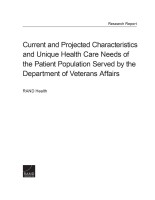| 来源类型 | Research Reports
|
| 规范类型 | 报告
|
| DOI | https://doi.org/10.7249/RR1165.1
|
| ISBN | 9780833092144
|
| 来源ID | RR-1165/1-VA
|
| Current and Projected Characteristics and Unique Health Care Needs of the Patient Population Served by the Department of Veterans Affairs |
| Christine Eibner; Heather Krull; Kristine Brown; Matthew Cefalu; Andrew W. Mulcahy; Michael Pollard; Kanaka Shetty; David M. Adamson; Ernesto F. L. Amaral; Philip Armour; et al.
|
| 发表日期 | 2015
|
| 出版年 | 2015
|
| 页码 | 388
|
| 语种 | 英语
|
| 结论 |
Veterans Are Better Off Than Non-Veterans, but VA Patients Are Older and Sicker Than the Veteran Population Overall- Veterans are older, have higher levels of education, and are less likely to be unemployed and live below the poverty line than non-veterans. Homelessness among veterans is also declining.
- Veterans have a higher prevalence of many common heath conditions than non-veterans. VA patients are older and less healthy than veterans who do not use VA health care, and the prevalence of many health conditions is expected to increase among VA patients over the next decade.
The Veteran and VA Patient Populations Will Shift in the Next Decade- The veteran population is projected to decrease by 19 percent over the next ten years, barring a major policy change or large-scale conflict. The number of veterans who rely on VA health care is expected to increase over the next five years and then level off after that period.
- The geographic distribution of veterans will change, with more veterans concentrated in urban areas. There will also be modest changes in the demographics of the veteran population.
VA Faces a Number of Challenges in Predicting Veterans' Health Care Needs- Most veterans who are eligible for VA health care have other sources of health coverage and rely on VA to meet only some of their health care needs. Predicting reliance on VA health care is difficult due to limitations in available data on veterans' health care use.
- Significant policy and eligibility changes and economic trends could affect the number of veterans who rely on VA health care.
|
| 摘要 |
- VA should prepare for a changing veteran population. The number of veterans and the size of the VA patient population will decrease over time, requiring decisions about how the VA health care system can best meet the needs of veterans in the future.
- VA should improve tracking of some veteran populations. Little is currently known about the utilization patterns and health care needs of new veterans, in particular.
- VA should anticipate shifts in the geographical distribution of veterans and align its facilities and services to meet these needs.
- VA should improve its processes for collecting data on veterans' health care utilization. Data on the sources of health care used by its patients, their diagnoses and treatments, and who pays for the services will help VA better understand veterans' health care needs and the extent to which they rely on VA.
- VA's demand projections should incorporate data on military separations and the health care needs of current service members. VA should have access to health care data on currently serving personnel to help it prepare for the new generation of veterans.
- VA should develop methods and models to test proposed policy changes and economic and demographic factors affecting veterans' health care needs.
|
| 主题 | Demographics
; Health Care Access
; Health Care Delivery Approaches
|
| URL | https://www.rand.org/pubs/research_reports/RR1165z1.html
|
| 来源智库 | RAND Corporation (United States)
|
| 引用统计 |
|
| 资源类型 | 智库出版物
|
| 条目标识符 | http://119.78.100.153/handle/2XGU8XDN/108154
|
推荐引用方式
GB/T 7714 |
Christine Eibner,Heather Krull,Kristine Brown,et al. Current and Projected Characteristics and Unique Health Care Needs of the Patient Population Served by the Department of Veterans Affairs. 2015.
|
|
文件名:
|
x1534530539456.jpg
|
|
格式:
|
JPEG
|

|
文件名:
|
RAND_RR1165z1.pdf
|
|
格式:
|
Adobe PDF
|
除非特别说明,本系统中所有内容都受版权保护,并保留所有权利。